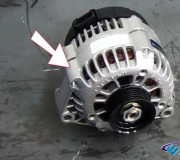The 4 or 5 days part is a little unclear. Other than that, you may need to thoroughly clean the battery cable ends at the battery. The alternator may charge 14 volts but is it getting into the battery? You can do a 'voltage drop' test at the cable ends to quickly diagonose them. Using a DVOM set to DC volts, connect one lead to the actual battery post and connect the other lead to the cable. (All cables are still connected to the battery) Read the meter. It should be really close to "0" volts. The higer the reading on the meter, the more voltage you're losing across the connection. Even if the reading is 10 or 11 volts, it could cause charging problems. Do this test on BOTH posts on the battery. Bad grounds can cause headaches, too. Also, check to see exactly how much voltage is at the big wire at the back of the altenator. It should be EXACTLY battery voltage. If it's ANY LESS, you're losing voltage somewhere. The altenator needs this voltage to charge properly. When you jump start it, you're replacing the voltage lost with voltage from another source, (jumper cables) therefore, it has the voltage required to start the car. If the cables are not making good contact at the battery, then when you remove the jumper cables, voltage to the vehicle is decreased, causing various problems. (Idle problems, etc.)
Sunday, October 19th, 2008 AT 4:34 PM




